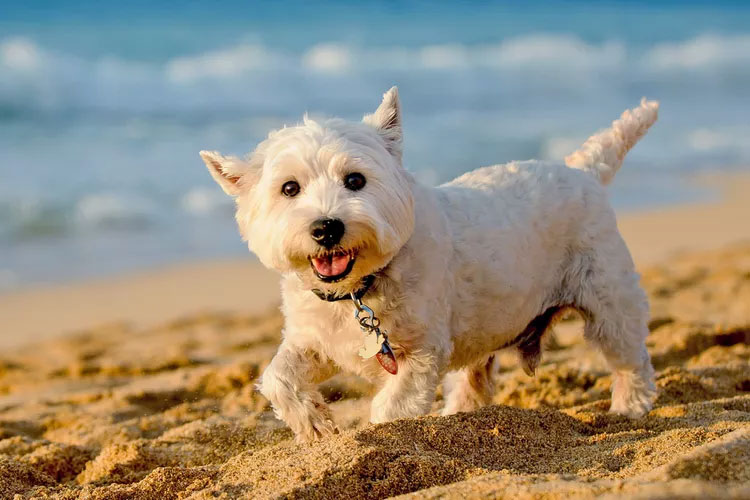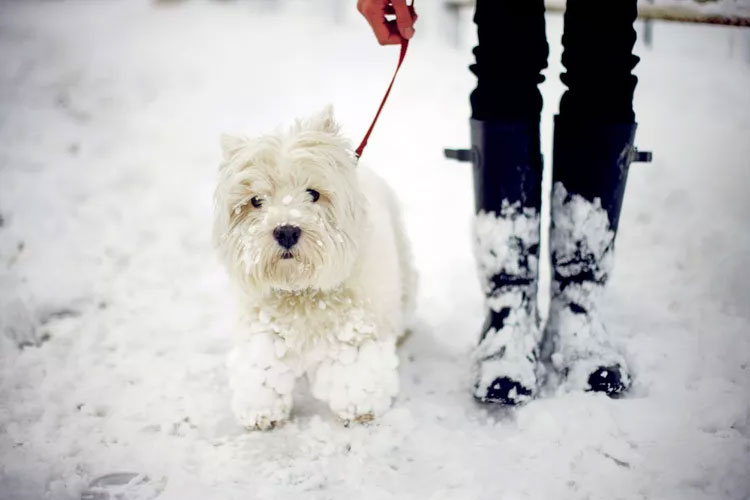
West Highland White Terrier (Westie) Overview
| OFFICIAL NAME | West Highland White Terrier (Westie) |
| COMMON NAME | West Highland White Terrier (Westie) |
| PET HEIGHT | 10 to 11 inches |
| PET WEIGHT | 15 to 20 pounds |
| LIFESPAN | 13 to 15 years |
| GOOD WITH | cats, children, dogs, families, seniors |
| TEMPERAMENT | friendly, outgoing, playful |
| INTELLIGENCE | high |
| SHEDDING AMOUNT | infrequent |
| EXERCISE NEEDS | high |
| ENERGY LEVEL | active |
| VOCAL LEVEL | frequent |
| DROOL AMOUNT | low |
| BREED GROUP | terrier |
| BREED SIZE | small (0-25 lbs.) |
| COAT LENGTH | short |
| COLORS | white |
| OTHER TRAITS | apartment-friendly, easy to groom, good hiking companion, high prey drive, tolerates being alone |
The West Highland white terrier, commonly called the Westie, is a small, hardy, and rambunctious breed that possesses no small amount of self-esteem. They're fun-loving and always excited to do anything with their owners, whether it be hiking and taking long walks outside or lying around the house and cuddling. The Westie's distinctive white coat—which feels tough rather than fluffy—sets them apart from their terrier relatives. And when their head is trimmed round and chrysanthemum-like, their little faces are irresistible.
But don't let that cuteness fool you: Despite being rather short in stature, there's not a lot a Westie is afraid of. The West Highland white terriers are excellent vermin hunters, and they will chase just about anything that moves. Known for their tenacity, adaptability, and affection for their humans, Westies are a long-loved breed (their lineage dates back to the 1800s!).
"Once you have built the trust between you and your Westie, they are amazing with moves and changes in environment," says Brittany Fowler, DVM, Small Animal Veterinary Internist. "As long as you are by their side, they tend to be pretty happy."
Appearance
The West Highland white terrier is easily identified by his characteristic white fur. This trademark coat acts like a mini suit of armor: The coarse outer fur protects him and his soft undercoat as he runs through rough shrubs to catch rats and small mammals. This special coat may be durable, but it does require regular light grooming. Stripping (or plucking) the old, dead hair is the traditional way of caring for the Westie's coat, but a visit to a professional groomer every four to six weeks for a trim is a practical timesaver. Overall, West Highland white terriers don't shed much and daily brushing will keep his coat in top shape and unmatted.
Along with their white coat, this small dog breed has a cute carrot-shaped tail, pointy ears, dark eyes, and a black button nose. Male Westie terriers grow to be about 11 inches tall, while females will be just a smidge shorter at 10 inches. They weigh in anywhere from 13–22 pounds, so they're the perfect size for your lap.
Temperament
Both a hunter and a snuggler, these little guys are very affectionate with their owners while also fostering a strong prey drive. They have a predisposition to run and chase (after hundreds of years of being bred to hunt rats and other rodents), so it's a good idea to keep your terrier on a leash or make sure he has a fenced-in yard to play in.The West Highland white terrier is just as smart as he is scrappy, so while it might take patience, he can be quite well-trained.

"Like many other terrier breeds, they are high-energy dogs and very independent, so they need an owner who has sufficient time to work with them on training, obedience, and to help them get outside regularly and burn off some excess energy," says Sarah Moore, DVM, Diplomate ACVIM (Neurology). "They may benefit from consistency and someone who is dedicated to working with them on training and behavior."
Because they're great problem-solvers and total people pleasers, Westies are a breed that does well with agility training. West Highland white terrier puppies are especially full of energy and need plenty of activity during the day—playing, hunting, and going for walks—to become snuggle bunnies at night.
Westies are wonderful family pets. They get along well with cats and other dogs, and they are social butterflies that love being around people. But because of their hunting instincts, young children might not be a great fit for the easily excitable Westie. Make sure your Westie has continual socialization experiences starting in puppyhood.
"I would always caution families with small children under seven years old with getting a Westie, unless they will always be supervised and have consistent training with the adults in the house," Fowler says.

Living Needs
Westies thrive with their people. It doesn't matter if you're a city dweller or live on a farm—they can be happy with apartment living (with lots of walkies) or on acres of land. And while they need to live primarily indoors and be close to their humans in order to deter undesirable behaviors like barking and digging—attributes that, according to the West Highland White Terrier Club of America, were bred to make effective hunters—Westies love to run around, be outside, and dirty up their white fur."I think one of their unique features is how much they enjoy being outside and do outdoor activities like long walks and real hikes," Fowler says. "There is a large misconception that small dogs just like to be inside, held all the time, [and] cannot touch the floor. If that's what you are looking for, then a Westie is not for you."
When you do take your Westie outside, make sure he's inside a fenced-in yard or kept on a leash. Otherwise, he might fall victim to the irresistible temptation of a squirrel and take off after it. While West Highland white terriers can be left alone for longer periods of time, they appreciate the noise of a TV or radio to keep them company, and they definitely need plenty of toys so they stay busy and active. And don't forget to pencil in play time—it's what Westies love best.
Care
Westies are not high-maintenance dogs when it comes to grooming, but they do require daily brushing—thankfully, mud picked up during their outside zoomies comes out easily. Their short, double coat isn't prone to shedding, so don't worry about finding little white hairs clinging to your couch or clothes. Simple brushing and regular trips to the groomer will keep their fur gleaming.But while they look cute and show dog-worthy with a perfectly trimmed round head, West Highland white terriers are not dogs that particularly enjoy being pampered.
"Even though they are small dogs, they don't tend to be prissy or delicate," Moore says. "A really unique feature of the breed is the fact that they can so comfortably share both favored family pet status as well as be competitive athletes that participate in things like agility, time trials, and hunting sports."

Westies are strong-willed and independent, characteristics that might require additional patience when training. But they're also intelligent, and with consistent positive reinforcement training, they will learn to stop digging in your yard and barking at birds. Just remember: Always keep your Westie on a leash when out and about, no matter how well he's been trained.
"Being a terrier, they were bred to hunt vermin and small predators," Fowler says. "So having a Westie you can trust to ever be off leash is very rare. You have to prepare for the most diligent training with consistency, while still knowing you might never be able to have a dog that's going to listen to you off leash if a chipmunk or squirrel runs by."
Health
The West Highland white terrier is a relatively healthy breed and typically lives to be between 12 and 15 years old. But, as with all breeds, there are certain health issues that can arise.Common ailments include a form of dry eye called keratoconjunctivitis sicca, as well as mild to moderate orthopedic problems in their hips and kneecaps.
Westies are also prone to allergies that affect their skin. When left untreated, this can turn into infections. Keep an eye out for itchy paws and head or ear shaking.
They may also deal with Addison's disease (a hormonal problem with the adrenal glands), Mitral valve endocardiosis (heart valve issue), and Pulmonary fibrosis.

History
Like many of the terriers Westies are related to (including the Scottish, Skye, and Cairn), they were bred to be the bonafide rodent hunters of the British Isles. According to the official breed club, Colonel Edward Donald Malcolm first bred the terriers to have their characteristic white coat in the 1800s so they would be easily distinguishable from foxes.Primarily used as hunters for years, Westies began appearing in dog shows in the early 1900s—the first West Highland white terrier was registered with the American Kennel Club in 1908—and have remained popular ever since.
Fun Facts
The Westie was originally known as the Poltalloch terrier and the Roseneath terrier before officially named the West Highland white terrier.Because the Westie once hunted fox, they were bred for their distinctive white coat so they could be easily spotted and differentiated from the animals they were hunting.
The Westie has been the long-running mascot for Cesar dog food.